See Page 1 |
2 |
3 |
4 | of the February 2024 homepage archives. Thursday the 29th
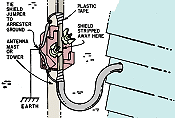 My family's house where I grew up (well,
got older) was probably typical of most when it came to mounting television antennas
on the roof and
running the twin−lead, 300-ohm transmission cable down to a point where it entered
the house, and then from there to the TV set. In retrospect, it was a miracle the
system worked any better than just hooking up the rabbit ears on top of the set.
If nothing else, it demonstrated how much better a roof-mounted antenna was than
just rabbit ears (unless you lived very close to the broadcast tower). If I remember
correctly, the first picture in the article showing how "not" to run your cable
into the house is the way we did it. I didn't even know there was a socket and plug
available for the twin−lead, nor did it occur to me or my father that drilling a
hole through the side of the house was an option (our house had too many unplanned
holes as it was). This 1967 Radio−Electronics magazine article covers the basics
of the proper method for routing the twin-lead cable. While it does mention the
use of impedance matched power splitters, no instruction is offered on why or how
to do it. Neither is there mention of the need to properly terminate unused jacks
in order to keep everything working at an optimal level... My family's house where I grew up (well,
got older) was probably typical of most when it came to mounting television antennas
on the roof and
running the twin−lead, 300-ohm transmission cable down to a point where it entered
the house, and then from there to the TV set. In retrospect, it was a miracle the
system worked any better than just hooking up the rabbit ears on top of the set.
If nothing else, it demonstrated how much better a roof-mounted antenna was than
just rabbit ears (unless you lived very close to the broadcast tower). If I remember
correctly, the first picture in the article showing how "not" to run your cable
into the house is the way we did it. I didn't even know there was a socket and plug
available for the twin−lead, nor did it occur to me or my father that drilling a
hole through the side of the house was an option (our house had too many unplanned
holes as it was). This 1967 Radio−Electronics magazine article covers the basics
of the proper method for routing the twin-lead cable. While it does mention the
use of impedance matched power splitters, no instruction is offered on why or how
to do it. Neither is there mention of the need to properly terminate unused jacks
in order to keep everything working at an optimal level...
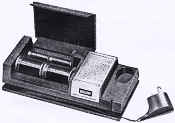 Nickel cadmium (NiCd or NiCad) and nickel
metal hydride (NiMH) batteries are classified as secondary cells because they are
rechargeable. Primary cells like carbon and standard alkaline are not rechargeable.
Those were the most common types of batteries- at least for consumer products -
up through the late 1980s. The now-common lithium ion (Li-Ion or LiIon) and lithium
polymer (Li-Po or LiPo) are also secondary types. Devices designed to use either
lithium chemistry are meant to work at integer multiples of the nominal 3.7 V cells
potential. In the mid 1980s, when NiMH was gaining popularity as a high energy density
rechargeable battery, a lot of people (including myself) began using them instead
of standard alkaline batteries in cameras, radios, toys, etc. The problem was, though,
that both NiCd and NiMH cells have a nominal voltage of just 1.2 V, which meant
that the operation time of the device was often less than with a disposable alkaline
or carbon battery. A lot of electronic devices designed for 1.5 V per cell
barely function at 1.2 V. Rechargeable alkaline batteries, which still had
a 1.5 V nominal voltage, were/are the compromise solution to that scenario.
Energy density of an alkaline compared to a NiMH battery is typically much less,
but they still provide better economy than using disposable batteries... Nickel cadmium (NiCd or NiCad) and nickel
metal hydride (NiMH) batteries are classified as secondary cells because they are
rechargeable. Primary cells like carbon and standard alkaline are not rechargeable.
Those were the most common types of batteries- at least for consumer products -
up through the late 1980s. The now-common lithium ion (Li-Ion or LiIon) and lithium
polymer (Li-Po or LiPo) are also secondary types. Devices designed to use either
lithium chemistry are meant to work at integer multiples of the nominal 3.7 V cells
potential. In the mid 1980s, when NiMH was gaining popularity as a high energy density
rechargeable battery, a lot of people (including myself) began using them instead
of standard alkaline batteries in cameras, radios, toys, etc. The problem was, though,
that both NiCd and NiMH cells have a nominal voltage of just 1.2 V, which meant
that the operation time of the device was often less than with a disposable alkaline
or carbon battery. A lot of electronic devices designed for 1.5 V per cell
barely function at 1.2 V. Rechargeable alkaline batteries, which still had
a 1.5 V nominal voltage, were/are the compromise solution to that scenario.
Energy density of an alkaline compared to a NiMH battery is typically much less,
but they still provide better economy than using disposable batteries...
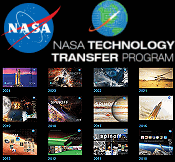 Ever since the manned space
exploration programs began at NASA (National Aeronautics and Space Administration),
controversy over both the financial costs and the cost in lost opportunity for other
government funded programs has existed. Many people, myself included, have always
championed the efforts and believe the axiom of the whole being greater than the
sum of the parts applies to the efforts. Opponents say resources would be better
spent here on Earth. In fact, we have always done both. To address the issue,
NASA Spinoff
was created to publicize the byproducts of the space program that benefit other
areas of research, manufacturing, and society. Since at least the 1970s, NASA has
published a monthly magazine entitled
NASA Tech Briefs
to inform the public on their activities, inviting readers to submit ideas and to
request information on how to apply NASA research to commercial applications. I
have been a regular reader since around 1980... Ever since the manned space
exploration programs began at NASA (National Aeronautics and Space Administration),
controversy over both the financial costs and the cost in lost opportunity for other
government funded programs has existed. Many people, myself included, have always
championed the efforts and believe the axiom of the whole being greater than the
sum of the parts applies to the efforts. Opponents say resources would be better
spent here on Earth. In fact, we have always done both. To address the issue,
NASA Spinoff
was created to publicize the byproducts of the space program that benefit other
areas of research, manufacturing, and society. Since at least the 1970s, NASA has
published a monthly magazine entitled
NASA Tech Briefs
to inform the public on their activities, inviting readers to submit ideas and to
request information on how to apply NASA research to commercial applications. I
have been a regular reader since around 1980...
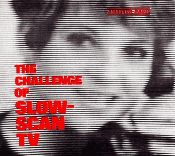 You would be forgiven if you think a technology
as crude as
slow-scan television (SSTV) has gone out of vogue with live YouTube videos and
webcams, but such is not the case. What has changed is the portion of Amateur Radio
spectrum allocated to SSTV and which classes of license holders may use it. Of course
the equipment used has been modernized, but vintage systems still work. Originally,
only Advanced class ticket holders were allowed access, but nowadays all Hams may
operate SSTV, including the entry level Technician class. SSTV was used extensively
on space exploration platforms including Apollo; in fact the historic Apollo 11
video feed of astronauts Armstrong and Aldrin hopping around on the moon were transmitted
via SSTV. ARISS (Amateur Radio on the International Space Station) regularly transmits
via SSTV... You would be forgiven if you think a technology
as crude as
slow-scan television (SSTV) has gone out of vogue with live YouTube videos and
webcams, but such is not the case. What has changed is the portion of Amateur Radio
spectrum allocated to SSTV and which classes of license holders may use it. Of course
the equipment used has been modernized, but vintage systems still work. Originally,
only Advanced class ticket holders were allowed access, but nowadays all Hams may
operate SSTV, including the entry level Technician class. SSTV was used extensively
on space exploration platforms including Apollo; in fact the historic Apollo 11
video feed of astronauts Armstrong and Aldrin hopping around on the moon were transmitted
via SSTV. ARISS (Amateur Radio on the International Space Station) regularly transmits
via SSTV...
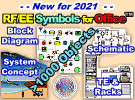 It was a lot of work, but I finally finished
a version of the "RF &
Electronics Schematic & Block Diagram Symbols"" that works well with Microsoft
Office™ programs Word™, Excel™, and Power Point™. This is an equivalent of the extensive
set of amplifier, mixer, filter, switch, connector, waveguide, digital, analog,
antenna, and other commonly used symbols for system block diagrams and schematics
created for Visio™. Each of the 1,000+ symbols was exported individually from Visio
in the EMF file format, then imported into Word on a Drawing Canvas. The EMF format
allows an image to be scaled up or down without becoming pixelated, so all the shapes
can be resized in a document and still look good. The imported symbols can also
be UnGrouped into their original constituent parts for editing... It was a lot of work, but I finally finished
a version of the "RF &
Electronics Schematic & Block Diagram Symbols"" that works well with Microsoft
Office™ programs Word™, Excel™, and Power Point™. This is an equivalent of the extensive
set of amplifier, mixer, filter, switch, connector, waveguide, digital, analog,
antenna, and other commonly used symbols for system block diagrams and schematics
created for Visio™. Each of the 1,000+ symbols was exported individually from Visio
in the EMF file format, then imported into Word on a Drawing Canvas. The EMF format
allows an image to be scaled up or down without becoming pixelated, so all the shapes
can be resized in a document and still look good. The imported symbols can also
be UnGrouped into their original constituent parts for editing...
Wednesday the 28th
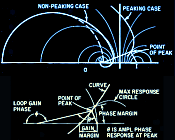 Phase, feedback, and instability, which
happens to be the title of this 1964 Radio-Electronics magazine article, has never
been my forte. The controls course I had in college was one of the most challenging
of all, along with semiconductor physics. For some reason, I had trouble figuring
out how to construct the formulas properly in the more complex systems. It was an
intensive exercise in applying LaPlace transforms. Controls class was one of the
very few courses in which I did not receive at least an A-. Anyway, the math presented
in this article is very basic and will not be a stumbling block to understating
the basic principle of feedback. You cannot study feedback and instability without
being comfortable with a little geometry and trigonometry, so be prepared. Author
Crowhurst does not get into poles and zeroes in the right-half and left-half regions
of the complex plane, so that will prevent a few anxiety attacks from his readers
;-) ... Phase, feedback, and instability, which
happens to be the title of this 1964 Radio-Electronics magazine article, has never
been my forte. The controls course I had in college was one of the most challenging
of all, along with semiconductor physics. For some reason, I had trouble figuring
out how to construct the formulas properly in the more complex systems. It was an
intensive exercise in applying LaPlace transforms. Controls class was one of the
very few courses in which I did not receive at least an A-. Anyway, the math presented
in this article is very basic and will not be a stumbling block to understating
the basic principle of feedback. You cannot study feedback and instability without
being comfortable with a little geometry and trigonometry, so be prepared. Author
Crowhurst does not get into poles and zeroes in the right-half and left-half regions
of the complex plane, so that will prevent a few anxiety attacks from his readers
;-) ...
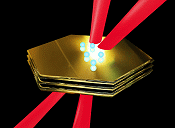 "Gold has long been a popular way of enhancing
the photosensitivity of electronic devices such as biosensors, imaging systems,
energy harvesters and information processors. So far, the gold used has been polycrystalline,
but in the past few years various research groups have finessed techniques for producing
monocrystalline gold. Researchers led by Anatoly Zayats at King's College London,
UK and Giulia Tagliabue at École Polytechnique Fédérale de Lausanne in Switzerland
are now reporting that electrons in these new monocrystalline gold films behave
significantly differently from electrons in polycrystalline gold. 'We had surprises
that we did not expect,' Zayats tells Physics World. The differences, he adds, could
bring significant benefits for applications. Gold makes a useful photosensitizer
because it supports a resonant response in which the oscillating electromagnetic
field of the incident light makes electrons slosh back and forth collectively. This
collective motion is termed a plasmon, and as the oscillation comes out of phase,
energy in the plasmon passes on to electrons and positively-charged holes in the
gold. Thanks to this transfer of energy, the electrons develop an effective temperature
much higher than the material's equilibrium temperature. It is these 'hot' electrons
that are so useful at initiating chemical reactions, signaling photon detection,
stashing energy and so on..." "Gold has long been a popular way of enhancing
the photosensitivity of electronic devices such as biosensors, imaging systems,
energy harvesters and information processors. So far, the gold used has been polycrystalline,
but in the past few years various research groups have finessed techniques for producing
monocrystalline gold. Researchers led by Anatoly Zayats at King's College London,
UK and Giulia Tagliabue at École Polytechnique Fédérale de Lausanne in Switzerland
are now reporting that electrons in these new monocrystalline gold films behave
significantly differently from electrons in polycrystalline gold. 'We had surprises
that we did not expect,' Zayats tells Physics World. The differences, he adds, could
bring significant benefits for applications. Gold makes a useful photosensitizer
because it supports a resonant response in which the oscillating electromagnetic
field of the incident light makes electrons slosh back and forth collectively. This
collective motion is termed a plasmon, and as the oscillation comes out of phase,
energy in the plasmon passes on to electrons and positively-charged holes in the
gold. Thanks to this transfer of energy, the electrons develop an effective temperature
much higher than the material's equilibrium temperature. It is these 'hot' electrons
that are so useful at initiating chemical reactions, signaling photon detection,
stashing energy and so on..."
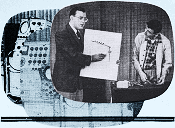 When I first saw this picture of Dr. Martin
L. Klein, I though he was Superman. No, it doesn't take a superman to teach
electronics on television, but the familiarity of George Reeves as the star of the
"Adventures of Superman" series in from 1953 through 1958 would have been a good
reason to use him in the
"Wires and Pliers" TV show. Dr. Klein and his techie sidekick Aram Solomonian
performed a weekly show presenting basic electronics to the audience. BTW, as long
as I am on a roll with misidentifications, I also looked up whether Dr. Klein
is related to the Klein Tools family. Klein has long been a producer of very high
quality hand tools for electricians (and others), hence, wires and pliers. Alas,
wrong on that one, too. I still own and use the Klein lineman's pliers, dikes, screwdrivers,
etc., that I bought nearly five decades ago when first entering the realm of electricianhood [sic]... When I first saw this picture of Dr. Martin
L. Klein, I though he was Superman. No, it doesn't take a superman to teach
electronics on television, but the familiarity of George Reeves as the star of the
"Adventures of Superman" series in from 1953 through 1958 would have been a good
reason to use him in the
"Wires and Pliers" TV show. Dr. Klein and his techie sidekick Aram Solomonian
performed a weekly show presenting basic electronics to the audience. BTW, as long
as I am on a roll with misidentifications, I also looked up whether Dr. Klein
is related to the Klein Tools family. Klein has long been a producer of very high
quality hand tools for electricians (and others), hence, wires and pliers. Alas,
wrong on that one, too. I still own and use the Klein lineman's pliers, dikes, screwdrivers,
etc., that I bought nearly five decades ago when first entering the realm of electricianhood [sic]...
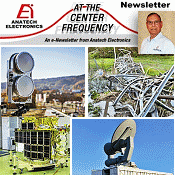 Sam Benzacar of Anatech Electronics, an
RF and microwave filter company, has published his February 2024 newsletter that,
along with timely news items, features his short op−ed entitled "Satellites
Join Terrestrial 5G," in which he summarizes the state of the art for satellite
direct to cell[phone] (DTC) communications. The massive satellite constellations
that are beginning to clutter the night sky (and the day sky, but that doesn't matter
much to visible light astronomers) have orbits low enough to make signal travel
time latency negligible compared to the quarter second or so for geostationary satellites.
LEO satellites be at around 330 miles above sea level and geostationary be
at around 22,236 miles, so LEO latency is roughly 2% that of geosynchronous.
Of course the latency also depends on how far from the phone's zenith the satellite
lies. While data rates for the mini Earth stations with a parabolic dish are in
the neighborhood of 10-20 Mbps, for a cellphone the rates are good enough for
text messaging (SMS), but that's about it. It's considered by many to be an emergency
mode at this point in DTC communications... Sam Benzacar of Anatech Electronics, an
RF and microwave filter company, has published his February 2024 newsletter that,
along with timely news items, features his short op−ed entitled "Satellites
Join Terrestrial 5G," in which he summarizes the state of the art for satellite
direct to cell[phone] (DTC) communications. The massive satellite constellations
that are beginning to clutter the night sky (and the day sky, but that doesn't matter
much to visible light astronomers) have orbits low enough to make signal travel
time latency negligible compared to the quarter second or so for geostationary satellites.
LEO satellites be at around 330 miles above sea level and geostationary be
at around 22,236 miles, so LEO latency is roughly 2% that of geosynchronous.
Of course the latency also depends on how far from the phone's zenith the satellite
lies. While data rates for the mini Earth stations with a parabolic dish are in
the neighborhood of 10-20 Mbps, for a cellphone the rates are good enough for
text messaging (SMS), but that's about it. It's considered by many to be an emergency
mode at this point in DTC communications...
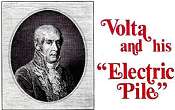 This 1973 Popular Electronics magazine
article has got to be one of the most concise and interesting summaries published
of
Alessandro Volta's path to the discovery of battery cells, aka "piles." Author
David Heiserman covers not just the technical aspects of Volta's experiments, but
the personal and political tip−toeing he needed to endure with contemporary physicist
Luigi Galvani and conqueror Napoleon Bonaparte, respectively. Alas, that has been
the case throughout history regarding not offending certain powerful people. Although
such unnecessary struggles continue to impede scientific advancement, at least the
unfettered access to the Internet has provided a venue for otherwise undiscoverable
work to be aired. Today, though, while you might not be tortured, imprisoned, or
murdered for your work, you can still be "cancelled" through delisting, denying
access to funds, blocking, and any number of other nefarious tactics. This 1973 Popular Electronics magazine
article has got to be one of the most concise and interesting summaries published
of
Alessandro Volta's path to the discovery of battery cells, aka "piles." Author
David Heiserman covers not just the technical aspects of Volta's experiments, but
the personal and political tip−toeing he needed to endure with contemporary physicist
Luigi Galvani and conqueror Napoleon Bonaparte, respectively. Alas, that has been
the case throughout history regarding not offending certain powerful people. Although
such unnecessary struggles continue to impede scientific advancement, at least the
unfettered access to the Internet has provided a venue for otherwise undiscoverable
work to be aired. Today, though, while you might not be tortured, imprisoned, or
murdered for your work, you can still be "cancelled" through delisting, denying
access to funds, blocking, and any number of other nefarious tactics.
 This assortment of custom-designed themes
by RF Cafe includes T-Shirts, Mouse Pads, Clocks, Tote Bags, Coffee Mugs and Steins,
Purses, Sweatshirts, Baseball Caps, and more, all sporting my amazingly clever "RF Engineers - We Are the World's
Matchmakers" Smith chart design. These would make excellent gifts for husbands,
wives, kids, significant others, and for handing out at company events or as rewards
for excellent service. My graphic has been ripped off by other people and used on
their products, so please be sure to purchase only official RF Cafe gear. I only
make a couple bucks on each sale - the rest goes to Cafe Press. It's a great way
to help support RF Cafe. Thanks... This assortment of custom-designed themes
by RF Cafe includes T-Shirts, Mouse Pads, Clocks, Tote Bags, Coffee Mugs and Steins,
Purses, Sweatshirts, Baseball Caps, and more, all sporting my amazingly clever "RF Engineers - We Are the World's
Matchmakers" Smith chart design. These would make excellent gifts for husbands,
wives, kids, significant others, and for handing out at company events or as rewards
for excellent service. My graphic has been ripped off by other people and used on
their products, so please be sure to purchase only official RF Cafe gear. I only
make a couple bucks on each sale - the rest goes to Cafe Press. It's a great way
to help support RF Cafe. Thanks...
Tuesday the 27th
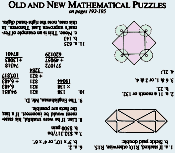 Here is another set of "Old
and New Mathematical Puzzles," compliments of the 1985 edition of the Old Farmer's
Almanac. All of the puzzles from Difficulty 1 through Difficulty 3 can
be worked out without much trouble. Puzzle number 3 is a variation on an optical
illusion based on the Möbius strip, or maybe more like a Klein bottle. Of course,
being a farmer thing, there's a puzzle involving the number and price of produce
at the market. There are four Difficulty 5 puzzles for which no solutions are
given. They are the ones where readers are invited to submit solutions, and the
winner for each receives a $50 award and honorable mention in the next year's edition.
The winning solutions are never shown, but you can write to request a copy of them.
It would be interesting to see what the solutions look like for this year's puzzle 13.
You need to be good at three-dimensional drawing to render them... Here is another set of "Old
and New Mathematical Puzzles," compliments of the 1985 edition of the Old Farmer's
Almanac. All of the puzzles from Difficulty 1 through Difficulty 3 can
be worked out without much trouble. Puzzle number 3 is a variation on an optical
illusion based on the Möbius strip, or maybe more like a Klein bottle. Of course,
being a farmer thing, there's a puzzle involving the number and price of produce
at the market. There are four Difficulty 5 puzzles for which no solutions are
given. They are the ones where readers are invited to submit solutions, and the
winner for each receives a $50 award and honorable mention in the next year's edition.
The winning solutions are never shown, but you can write to request a copy of them.
It would be interesting to see what the solutions look like for this year's puzzle 13.
You need to be good at three-dimensional drawing to render them...
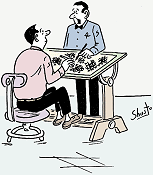 Close out this day with a tech-themed comic
from a 1972 issue of Popular Electronics magazine (only one this time). Those of
you who entered the engineering realm sometime after the 1990s might not recognize
the strange looking surface the guy is sitting behind. It was an early tabletop
touch-type display where the stylus with which the user created an image (drawing)
was a wooden stick with a round shaft of graphite located coaxially in the center.
The pointed, relatively soft tip wore down rather quickly and required frequent
reshaping to maintain a constant pixel width in the lines. Portions of drawings
made on those devices could only be erased and redrawn a few times as with modern
solid-state drives. Cutting and pasting required physical cutting and pasting (or
taping). Clipboards were often used to hold frequently replicated snippets of renderings
(title blocks, standard drawing notes, etc.) for pasting into a drawing. One big
drawback of those older drawing programs was that after a day's work you usually
went home with a layer of graphite on your palm and shirtsleeve... Close out this day with a tech-themed comic
from a 1972 issue of Popular Electronics magazine (only one this time). Those of
you who entered the engineering realm sometime after the 1990s might not recognize
the strange looking surface the guy is sitting behind. It was an early tabletop
touch-type display where the stylus with which the user created an image (drawing)
was a wooden stick with a round shaft of graphite located coaxially in the center.
The pointed, relatively soft tip wore down rather quickly and required frequent
reshaping to maintain a constant pixel width in the lines. Portions of drawings
made on those devices could only be erased and redrawn a few times as with modern
solid-state drives. Cutting and pasting required physical cutting and pasting (or
taping). Clipboards were often used to hold frequently replicated snippets of renderings
(title blocks, standard drawing notes, etc.) for pasting into a drawing. One big
drawback of those older drawing programs was that after a day's work you usually
went home with a layer of graphite on your palm and shirtsleeve...
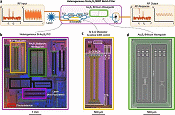 "It's a very safe bet that a wireless or
wired system uses at least one filter - and likely many more - in their various
forms: low-pass, high-pass, notch, or bandpass. As operating frequencies increase
into the gigahertz and tens of gigahertz range, it's increasingly difficult to create
filters with narrow bandpass or notch performance, especially using discrete-device
versions which are almost always impractical in that range. While there are ways
to create such filters using surface-acoustic-wave (SAW) and bulk-acoustic-wave
(BAW) technologies, even these technologies struggle to keep up with the demands
for narrow bandwidth filtering at these ever-higher frequencies. Recognizing the
need and opportunity, the photonic and electro-optical (E-O) community is doing
a great deal of research to overcome these barriers. For example, researchers at
the University of Sydney (Australia) Nano Institute devised a compact semiconductor
chip that provides for the
heterogeneous integration of chalcogenide glass with silicon to create specialty
filters. Their effort has resulted in a notch filter with narrow 37-MHz 3-dB bandwidth..." "It's a very safe bet that a wireless or
wired system uses at least one filter - and likely many more - in their various
forms: low-pass, high-pass, notch, or bandpass. As operating frequencies increase
into the gigahertz and tens of gigahertz range, it's increasingly difficult to create
filters with narrow bandpass or notch performance, especially using discrete-device
versions which are almost always impractical in that range. While there are ways
to create such filters using surface-acoustic-wave (SAW) and bulk-acoustic-wave
(BAW) technologies, even these technologies struggle to keep up with the demands
for narrow bandwidth filtering at these ever-higher frequencies. Recognizing the
need and opportunity, the photonic and electro-optical (E-O) community is doing
a great deal of research to overcome these barriers. For example, researchers at
the University of Sydney (Australia) Nano Institute devised a compact semiconductor
chip that provides for the
heterogeneous integration of chalcogenide glass with silicon to create specialty
filters. Their effort has resulted in a notch filter with narrow 37-MHz 3-dB bandwidth..."
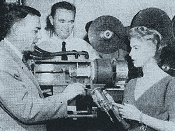 Wireless power distribution has been in
the news a lot for the last few years. It began with a goal of just wirelessly charging
mobile devices like cellphones, smart watches, and tablet computers. Next came articles
about charging electric cars wirelessly while sitting in a parking lot or garage,
or even at a stop light. In each instance, the item being charged needed to sit
in close proximity to an electric induction coil to be effective. Just a couple
days ago, however, a new item appeared where Disney Research has come up with a
"quasistatic cavity resonance" system that covers an entire room. This story from
a 1956 edition of Popular Electronics magazine reports on an incandescent
lamp powered wirelessly by an RF energy source. It's not quite the same thing, but
is the same basic principle... Wireless power distribution has been in
the news a lot for the last few years. It began with a goal of just wirelessly charging
mobile devices like cellphones, smart watches, and tablet computers. Next came articles
about charging electric cars wirelessly while sitting in a parking lot or garage,
or even at a stop light. In each instance, the item being charged needed to sit
in close proximity to an electric induction coil to be effective. Just a couple
days ago, however, a new item appeared where Disney Research has come up with a
"quasistatic cavity resonance" system that covers an entire room. This story from
a 1956 edition of Popular Electronics magazine reports on an incandescent
lamp powered wirelessly by an RF energy source. It's not quite the same thing, but
is the same basic principle...
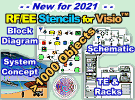 With more than 1000
custom-built stencils, this has got to be the most comprehensive set of
Visio Stencils
available for RF, analog, and digital system and schematic drawings! Every stencil
symbol has been built to fit proportionally on the included A-, B-, and C-size drawing
page templates (or use your own page if preferred). Components are provided for
system block diagrams, conceptual drawings, schematics, test equipment, racks, and
more. Page templates are provided with a preset scale (changeable) for a good presentation
that can incorporate all provided symbols... With more than 1000
custom-built stencils, this has got to be the most comprehensive set of
Visio Stencils
available for RF, analog, and digital system and schematic drawings! Every stencil
symbol has been built to fit proportionally on the included A-, B-, and C-size drawing
page templates (or use your own page if preferred). Components are provided for
system block diagrams, conceptual drawings, schematics, test equipment, racks, and
more. Page templates are provided with a preset scale (changeable) for a good presentation
that can incorporate all provided symbols...
Monday the 26th
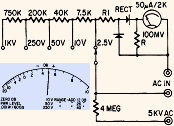 Prior to the advent of meters with a super
high input impedance (>1 MΩ) featuring field effect transistors (FETs),
accurate use of a voltmeter or ohmmeter required knowledge of the
meter's internal resistance and the resistance of the device under test (DUT).
As can be seen in Figure 2, various range settings on the meter resulted in
different internal resistances. The internal resistance of the meter in series with
the resistance of the DUT form a voltage divider where the indicated voltage is
less than that which would be indicated if the meter's internal resistance was much
higher. Author Robert Middleton presents examples of possible errors when measuring
voltage, current, and resistance. Many modern digital multimeters (DMMs) have an
input impedance of at least 10 MΩ, so very few scenarios would require minding
the meter characteristics. With DMMs there is also no need to learn how to interpret
the multiple needle scale markings, or to take care to avoid parallax error as a
result of not looking at the needle from directly perpendicular to the scale markings,
or keeping track of the reading units (mV, V, mA, A, Ω, kΩ, MΩ... Prior to the advent of meters with a super
high input impedance (>1 MΩ) featuring field effect transistors (FETs),
accurate use of a voltmeter or ohmmeter required knowledge of the
meter's internal resistance and the resistance of the device under test (DUT).
As can be seen in Figure 2, various range settings on the meter resulted in
different internal resistances. The internal resistance of the meter in series with
the resistance of the DUT form a voltage divider where the indicated voltage is
less than that which would be indicated if the meter's internal resistance was much
higher. Author Robert Middleton presents examples of possible errors when measuring
voltage, current, and resistance. Many modern digital multimeters (DMMs) have an
input impedance of at least 10 MΩ, so very few scenarios would require minding
the meter characteristics. With DMMs there is also no need to learn how to interpret
the multiple needle scale markings, or to take care to avoid parallax error as a
result of not looking at the needle from directly perpendicular to the scale markings,
or keeping track of the reading units (mV, V, mA, A, Ω, kΩ, MΩ...
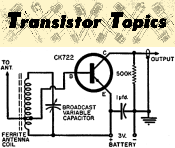 Popular Electronics magazine ran their
"Transistor
Topics" column for many years, and this is the third in the series. Unfortunately,
I do not yet have the previous two editions, but someday... Transistors were a relatively
new phenomenon at the beginning of 1956, so there was a lot to learn and a lot of
people to teach about them. It might have been easier to make converts of dedicated
tube users if the JFET (junction field effect transistor) had been commercialized
before the BJT (bipolar junction transistor), since the JFET (voltage on the gate
controls current flow) acts more like the familiar vacuum tube (voltage on the control
grid controls current flow) than the BJT (current on the base controls current flow)... Popular Electronics magazine ran their
"Transistor
Topics" column for many years, and this is the third in the series. Unfortunately,
I do not yet have the previous two editions, but someday... Transistors were a relatively
new phenomenon at the beginning of 1956, so there was a lot to learn and a lot of
people to teach about them. It might have been easier to make converts of dedicated
tube users if the JFET (junction field effect transistor) had been commercialized
before the BJT (bipolar junction transistor), since the JFET (voltage on the gate
controls current flow) acts more like the familiar vacuum tube (voltage on the control
grid controls current flow) than the BJT (current on the base controls current flow)...
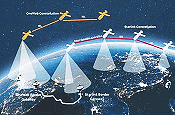 "The formation of the
Mobile Satellite Services Association (MSSA) marks a significant stride towards
enhancing global connectivity through the emerging Direct-to-Device (D2D) and Internet
of Things (IoT) services. Leading entities in the satellite communications sector,
including Viasat, Inc., Terrestar Solutions, Ligado Networks, Omnispace, and Al
Yah Satellite Communications Company PJSC (Yahsat), have come together to establish
this non-profit industry consortium. The MSSA's mission is to harness over 100 MHz
of L- and S-band spectrum-already allocated and licensed for mobile satellite services
(MSS)-to build a robust global ecosystem that integrates seamlessly into a wide
array of mobile devices. The Association's alignment with 3rd Generation Partnership
Project (3GPP) standards is a critical move to broaden terrestrial mobile coverage,
including for Mobile Network Operator (MNO) and Over-the-Top (OTT) internet services.
This strategic initiative underscores the inherent advantages of MSS licensed spectrum,
such as the capability for existing space networks to instantly provide Narrowband
Internet of Things (NB-IoT) services..." "The formation of the
Mobile Satellite Services Association (MSSA) marks a significant stride towards
enhancing global connectivity through the emerging Direct-to-Device (D2D) and Internet
of Things (IoT) services. Leading entities in the satellite communications sector,
including Viasat, Inc., Terrestar Solutions, Ligado Networks, Omnispace, and Al
Yah Satellite Communications Company PJSC (Yahsat), have come together to establish
this non-profit industry consortium. The MSSA's mission is to harness over 100 MHz
of L- and S-band spectrum-already allocated and licensed for mobile satellite services
(MSS)-to build a robust global ecosystem that integrates seamlessly into a wide
array of mobile devices. The Association's alignment with 3rd Generation Partnership
Project (3GPP) standards is a critical move to broaden terrestrial mobile coverage,
including for Mobile Network Operator (MNO) and Over-the-Top (OTT) internet services.
This strategic initiative underscores the inherent advantages of MSS licensed spectrum,
such as the capability for existing space networks to instantly provide Narrowband
Internet of Things (NB-IoT) services..."
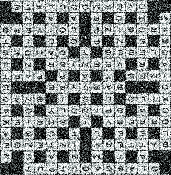 Regular RF Cafe visitors know I have a penchant
for creating and solving
crossword puzzles. Since around 2001, I have personally generated a new crossword
almost every week - hundreds in total. Some studies have suggested lower rates of
dementia in people who regularly exercise their brains, but that is not the primary
reason I work crossword, word scramble, and Sudoku puzzles - I enjoy the challenge.
A couple times each year, Popular Electronics magazine published an electronics-themed
crossword puzzle; however, unlike the crosswords I make, not all of the words and
clues have to do with technology and science. Still, they're a good pastime activity... Regular RF Cafe visitors know I have a penchant
for creating and solving
crossword puzzles. Since around 2001, I have personally generated a new crossword
almost every week - hundreds in total. Some studies have suggested lower rates of
dementia in people who regularly exercise their brains, but that is not the primary
reason I work crossword, word scramble, and Sudoku puzzles - I enjoy the challenge.
A couple times each year, Popular Electronics magazine published an electronics-themed
crossword puzzle; however, unlike the crosswords I make, not all of the words and
clues have to do with technology and science. Still, they're a good pastime activity...
 Banner Ads are rotated in all locations
on the page! RF Cafe typically receives 8,000-15,000 visits each
weekday. RF Cafe
is a favorite of engineers, technicians, hobbyists, and students all over the world.
With more than 17,000 pages in the Google search index, RF Cafe returns in
favorable positions on many types of key searches, both for text and images.
Your Banner Ads are displayed on average 280,000 times per year! New content
is added on a daily basis, which keeps the major search engines interested enough
to spider it multiple times each day. Items added on the homepage often can be found
in a Google search within a few hours of being posted. If you need your company
news to be seen, RF Cafe is the place to be... Banner Ads are rotated in all locations
on the page! RF Cafe typically receives 8,000-15,000 visits each
weekday. RF Cafe
is a favorite of engineers, technicians, hobbyists, and students all over the world.
With more than 17,000 pages in the Google search index, RF Cafe returns in
favorable positions on many types of key searches, both for text and images.
Your Banner Ads are displayed on average 280,000 times per year! New content
is added on a daily basis, which keeps the major search engines interested enough
to spider it multiple times each day. Items added on the homepage often can be found
in a Google search within a few hours of being posted. If you need your company
news to be seen, RF Cafe is the place to be...
Friday the 23rd
 Westinghouse, headquartered in and around
Pittsburgh, Pennsylvania, was a major force in all aspects of commercial broadcast
radio. The company designed, manufactured, installed, and managed broadcast studios
and transmission equipment. They also made some of the greatest complexity and quality
receivers. Many were truly masterpieces that complimented rooms outfitted with high
end furniture. Other companies like Crosley also made very large, multi-featured
consoles with record-changing phonographs, AM and shortwave receiver bands with
pushbutton tuning, AGC and AFC circuits, ample storage space for records, built-in
antennas, AC or DC operation, and other bells and whistles. Curvaceous solid and
plywood construction was solid and finishes had a deep luster. This full-page 1945
Life magazine advertisement was a pitch for what would have been one of
the first new radios sold at the end of World War II, during which all resources
had been dedicated to military equipment thanks to the War Powers Act of 1941. Although
not mentioned, I'm guessing the girl is the daughter of either John Charles Tomas
or Ted Malone... Westinghouse, headquartered in and around
Pittsburgh, Pennsylvania, was a major force in all aspects of commercial broadcast
radio. The company designed, manufactured, installed, and managed broadcast studios
and transmission equipment. They also made some of the greatest complexity and quality
receivers. Many were truly masterpieces that complimented rooms outfitted with high
end furniture. Other companies like Crosley also made very large, multi-featured
consoles with record-changing phonographs, AM and shortwave receiver bands with
pushbutton tuning, AGC and AFC circuits, ample storage space for records, built-in
antennas, AC or DC operation, and other bells and whistles. Curvaceous solid and
plywood construction was solid and finishes had a deep luster. This full-page 1945
Life magazine advertisement was a pitch for what would have been one of
the first new radios sold at the end of World War II, during which all resources
had been dedicated to military equipment thanks to the War Powers Act of 1941. Although
not mentioned, I'm guessing the girl is the daughter of either John Charles Tomas
or Ted Malone...
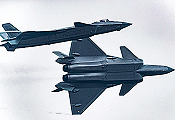 "A new-generation plasma stealth device
that can make almost any military aircraft vanish from a radar screen is claimed
to have been developed by a team of scientists and engineers from western China.
Unlike its predecessors, which generate a cloud of plasma draped over a plane, this
innovation can be tailored to fit a sensitive section of a military aircraft - areas
like the radar dome, cockpit or other spots that are most prone to enemy radar detection.
This 'closed
electron beam plasma stealth device,' which focuses on protecting key areas
instead of the entire aircraft, can be switched on at a moment's notice to fool
radar operators. It has many advantages such as 'simple structure, wide power adjustable
range and high plasma density,' Tan Chang, a scientist involved in the project,
wrote in a peer-reviewed paper published in the Chinese Journal of Radio Science
in December. Chinese scientists say they can use foreign military radar to track
ships. Plasma, composed of electrically charged particles, interacts with electromagnetic
waves in a unique way. When electromagnetic waves - such as those emitted by radar
- interact with plasma, they cause the particles to move rapidly and collide, dissipating
the waves' energy and reducing the strength of the reflected signal. This interaction
converts the energy... (line
546 in page source view for non-subscribers) "A new-generation plasma stealth device
that can make almost any military aircraft vanish from a radar screen is claimed
to have been developed by a team of scientists and engineers from western China.
Unlike its predecessors, which generate a cloud of plasma draped over a plane, this
innovation can be tailored to fit a sensitive section of a military aircraft - areas
like the radar dome, cockpit or other spots that are most prone to enemy radar detection.
This 'closed
electron beam plasma stealth device,' which focuses on protecting key areas
instead of the entire aircraft, can be switched on at a moment's notice to fool
radar operators. It has many advantages such as 'simple structure, wide power adjustable
range and high plasma density,' Tan Chang, a scientist involved in the project,
wrote in a peer-reviewed paper published in the Chinese Journal of Radio Science
in December. Chinese scientists say they can use foreign military radar to track
ships. Plasma, composed of electrically charged particles, interacts with electromagnetic
waves in a unique way. When electromagnetic waves - such as those emitted by radar
- interact with plasma, they cause the particles to move rapidly and collide, dissipating
the waves' energy and reducing the strength of the reflected signal. This interaction
converts the energy... (line
546 in page source view for non-subscribers)
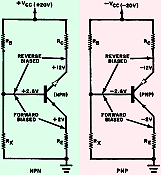 Believe it or not, there are still people
out there - engineers and hobbyists - who design circuits using discrete transistors.
Sure, there is a plethora of integrated circuits that combine multiple functions
into a single package that performs often nearly like ideal components, and for
a lot less money than building an equivalent circuit from individual components.
Still, sometimes a lone transistor with a couple biasing resistors will do the job,
and sometimes the designer just wants to do something different. There are also
plenty of instances where you need to find a replacement of a failed transistor
that has similar form, fit, and function. This article from a 1974 issue of Popular
Electronics magazine might be just the aid you need if you have found yourself in
need of selecting a transistor. Of course if your application is for high frequency,
there are parameters to consider other than those presented here, but it's a good
start... Believe it or not, there are still people
out there - engineers and hobbyists - who design circuits using discrete transistors.
Sure, there is a plethora of integrated circuits that combine multiple functions
into a single package that performs often nearly like ideal components, and for
a lot less money than building an equivalent circuit from individual components.
Still, sometimes a lone transistor with a couple biasing resistors will do the job,
and sometimes the designer just wants to do something different. There are also
plenty of instances where you need to find a replacement of a failed transistor
that has similar form, fit, and function. This article from a 1974 issue of Popular
Electronics magazine might be just the aid you need if you have found yourself in
need of selecting a transistor. Of course if your application is for high frequency,
there are parameters to consider other than those presented here, but it's a good
start...
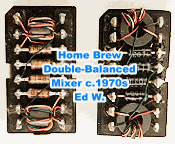  When RF Cafe visitor Ed W. saw the photo
I posted of the très cool looking miniature isolation transformers from the "Exploring Uncommon Applications of Isolation"
it reminded him of a double balanced mixer his company designed back in the 1970s
for a line of high frequency (HF) radios like the
Cubic
Astro 200.
At the time, it was considered more economical than a commercially made mixer. Unless
exceptionally high power handling is required, a modern
integrated double balanced mixer like this one from Marki Microwave will have
better higher performance because the diodes will all be nearly perfectly matched.
The same is true, of course, for triple balanced mixers. Double balanced mixers
tend to suppress odd order spur products to a greater degree than even order products,
while triple balanced mixers tend to suppress even order spur products to a greater
degree than odd order products. When RF Cafe visitor Ed W. saw the photo
I posted of the très cool looking miniature isolation transformers from the "Exploring Uncommon Applications of Isolation"
it reminded him of a double balanced mixer his company designed back in the 1970s
for a line of high frequency (HF) radios like the
Cubic
Astro 200.
At the time, it was considered more economical than a commercially made mixer. Unless
exceptionally high power handling is required, a modern
integrated double balanced mixer like this one from Marki Microwave will have
better higher performance because the diodes will all be nearly perfectly matched.
The same is true, of course, for triple balanced mixers. Double balanced mixers
tend to suppress odd order spur products to a greater degree than even order products,
while triple balanced mixers tend to suppress even order spur products to a greater
degree than odd order products.
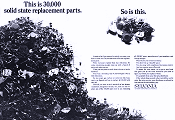 In 1970,
Sylvania ran this 2-page advertisement in Popular Electronics magazine
touting the accomplishment of reducing the equivalent of 60,000 discrete components
to a mere 60 - thanks to integrated circuits. That 1,000:1 ratio is miniscule compared
to this year (2017) where AMD's 24-core EPYC 7401P sports 19,200,000,000 transistors.
If Moore's Law continues, we can expect nearly 40 billion in another year and a
half. Sylvania was not claiming to be able to replace all components with integrated
circuits, just to drastically reduce the number of parts needed to stock for prototyping
and production. Even AMD's gigaprocessor needs a large handful of capacitors sprinkled
around its periphery to function in the presence of electrical noise and power fluctuations,
and also a few steering diodes and pull-up resistors. I don't dare make a statement
like, "There will always be a need for discrete passive components," because bioelectronics
might easily replace both discrete and integrated components with gelatinous blobs
of synapse-filled gray matter, powered by pseudo stomachs fed by frankenpellets
of nutrition... In 1970,
Sylvania ran this 2-page advertisement in Popular Electronics magazine
touting the accomplishment of reducing the equivalent of 60,000 discrete components
to a mere 60 - thanks to integrated circuits. That 1,000:1 ratio is miniscule compared
to this year (2017) where AMD's 24-core EPYC 7401P sports 19,200,000,000 transistors.
If Moore's Law continues, we can expect nearly 40 billion in another year and a
half. Sylvania was not claiming to be able to replace all components with integrated
circuits, just to drastically reduce the number of parts needed to stock for prototyping
and production. Even AMD's gigaprocessor needs a large handful of capacitors sprinkled
around its periphery to function in the presence of electrical noise and power fluctuations,
and also a few steering diodes and pull-up resistors. I don't dare make a statement
like, "There will always be a need for discrete passive components," because bioelectronics
might easily replace both discrete and integrated components with gelatinous blobs
of synapse-filled gray matter, powered by pseudo stomachs fed by frankenpellets
of nutrition...
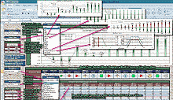 RF Cascade Workbook is the next phase in the evolution of RF Cafe's long-running
series, RF Cascade Workbook. Chances are you have never used a spreadsheet
quite like this (click
here for screen capture). It is a full-featured RF system cascade parameter
and frequency planner that includes filters and mixers for a mere $45. Built in
MS Excel, using RF Cascade Workbook is a cinch and the format
is entirely customizable. It is significantly easier and faster than using a multi-thousand
dollar simulator when a high level system analysis is all that is needed...
RF Cascade Workbook is the next phase in the evolution of RF Cafe's long-running
series, RF Cascade Workbook. Chances are you have never used a spreadsheet
quite like this (click
here for screen capture). It is a full-featured RF system cascade parameter
and frequency planner that includes filters and mixers for a mere $45. Built in
MS Excel, using RF Cascade Workbook is a cinch and the format
is entirely customizable. It is significantly easier and faster than using a multi-thousand
dollar simulator when a high level system analysis is all that is needed...
Thursday the 22nd
 "Semipermanent" magnetic memory is reported
here in this 1964 Radio−Electronics magazine news item. The term semipermanent
is an awfully good, clearly confusing, but seriously funny example of an oxymoron,
akin to jumbo shrimp, old news, random order, and unbiased opinion. An electronic
switching system is announced which will replace the massive network of electromechanical
switches in the nation's telephone system. Once implemented, the cacophony of clicking
relays heard inside the switch rooms containing thousands of of the noisy little
buggers would go silent. I remember being in such a facility in the mid-to-late
1970s where the electromechanical relays were still being used, so it was well over
a decade before a total switchover (see what I did there?) was completed. Also covered
was a computer built by Univac that used fluid amplifiers (literally a fluid, including
air). Also, there was news of the "World's Greatest Amateur," John L. Reinartz,
W1XAM, having attained Silent Key status... "Semipermanent" magnetic memory is reported
here in this 1964 Radio−Electronics magazine news item. The term semipermanent
is an awfully good, clearly confusing, but seriously funny example of an oxymoron,
akin to jumbo shrimp, old news, random order, and unbiased opinion. An electronic
switching system is announced which will replace the massive network of electromechanical
switches in the nation's telephone system. Once implemented, the cacophony of clicking
relays heard inside the switch rooms containing thousands of of the noisy little
buggers would go silent. I remember being in such a facility in the mid-to-late
1970s where the electromechanical relays were still being used, so it was well over
a decade before a total switchover (see what I did there?) was completed. Also covered
was a computer built by Univac that used fluid amplifiers (literally a fluid, including
air). Also, there was news of the "World's Greatest Amateur," John L. Reinartz,
W1XAM, having attained Silent Key status...
 "The
Army is testing a new rucksack that was purpose-built for radio operators to reduce
damage to systems on drops, add space, improve fit and cut down on heat. The
Radio Carrier Rucksack was assessed in airborne drops with soldiers at Yuma
Proving Ground, Arizona, according to an Army release. The radio ruck is being developed
by Natick Soldier Systems Center under the Army's Combat Capabilities Development
Command. Soldiers evaluated the ruck with both the AN/PRC-158 and AN/PRC-162 radios
in 'combat-realistic scenarios' to see whether the new setup could prevent damage
to radios during parachute jumps. Developers have modified the existing Modular
Lightweight Load-carrying Equipment assault pack that's fielded across the service.
'The radio harness allows the radio to be connected to the existing assault frame,
while the side pouches allow for individualized space to store antennas away from
other equipment and gear,' explained Bob Cohen, Manpack Lead Test Engineer..." "The
Army is testing a new rucksack that was purpose-built for radio operators to reduce
damage to systems on drops, add space, improve fit and cut down on heat. The
Radio Carrier Rucksack was assessed in airborne drops with soldiers at Yuma
Proving Ground, Arizona, according to an Army release. The radio ruck is being developed
by Natick Soldier Systems Center under the Army's Combat Capabilities Development
Command. Soldiers evaluated the ruck with both the AN/PRC-158 and AN/PRC-162 radios
in 'combat-realistic scenarios' to see whether the new setup could prevent damage
to radios during parachute jumps. Developers have modified the existing Modular
Lightweight Load-carrying Equipment assault pack that's fielded across the service.
'The radio harness allows the radio to be connected to the existing assault frame,
while the side pouches allow for individualized space to store antennas away from
other equipment and gear,' explained Bob Cohen, Manpack Lead Test Engineer..."
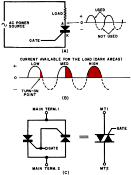 The
Triac (triode for alternating current) is not a component often used in RF and
microwave circuit design, but being conversant in its operation could make you popular
at nerd parties. A triac is basically the equivalent of two SCRs (silicon-controller
rectifier, aka thyristor) connected back-to-back, allowing it to conduct on both
the positive and negative half-cycles of an AC connection. Both devices are most
commonly used in switching applications. The unique feature of an SCR and triac
is that once the gate voltage is sufficiently high to begin conduction between the
anode and cathode, it can be removed and conduction will continue until the anode-cathode
voltage is removed (i.e., holding current removed). This 1974 Popular Electronics
magazine article introduces and explains the operation and applications for triacs... The
Triac (triode for alternating current) is not a component often used in RF and
microwave circuit design, but being conversant in its operation could make you popular
at nerd parties. A triac is basically the equivalent of two SCRs (silicon-controller
rectifier, aka thyristor) connected back-to-back, allowing it to conduct on both
the positive and negative half-cycles of an AC connection. Both devices are most
commonly used in switching applications. The unique feature of an SCR and triac
is that once the gate voltage is sufficiently high to begin conduction between the
anode and cathode, it can be removed and conduction will continue until the anode-cathode
voltage is removed (i.e., holding current removed). This 1974 Popular Electronics
magazine article introduces and explains the operation and applications for triacs...
 I,
for one, do not fear the emergence of artificial
intelligence (AI). The fact is we have been living through an evolutionary process
in AI since the beginning of the computer age - it just wasn't called AI at the
time. Electronic and mechanical CAD/CAE software with optimization routines are
AI. PCB layout autorouting is AI. Weather prediction algorithms are AI. MRI and
x-ray images processing is AI, as is tax preparation software. I'd say "get used
to it," but you already have. This Sora
project by OpenAI (the
ChatGPT folks) is basically a real-life rendition version of what
Pixar is for cartoon animation.
"We're teaching AI to understand and simulate the physical world in motion, with
the goal of training models that help people solve problems that require real-world
interaction. Sora can generate videos up to a minute long while maintaining visual
quality and adherence to the user's prompt. Sora is able to generate complex scenes
with multiple characters, specific types of motion, and accurate details of the
subject and background. The model understands not only what the user has asked for
in the prompt, but also how those things exist in the physical world. The current
model has weaknesses. For example, a person might take a bite out of a cookie, but
afterward, the cookie may not have a bite mark..." The movie industry is crying
foul, but honestly, would many people care if the egotistical, largely ignorant,
bloviating Hollywood actors went away? I,
for one, do not fear the emergence of artificial
intelligence (AI). The fact is we have been living through an evolutionary process
in AI since the beginning of the computer age - it just wasn't called AI at the
time. Electronic and mechanical CAD/CAE software with optimization routines are
AI. PCB layout autorouting is AI. Weather prediction algorithms are AI. MRI and
x-ray images processing is AI, as is tax preparation software. I'd say "get used
to it," but you already have. This Sora
project by OpenAI (the
ChatGPT folks) is basically a real-life rendition version of what
Pixar is for cartoon animation.
"We're teaching AI to understand and simulate the physical world in motion, with
the goal of training models that help people solve problems that require real-world
interaction. Sora can generate videos up to a minute long while maintaining visual
quality and adherence to the user's prompt. Sora is able to generate complex scenes
with multiple characters, specific types of motion, and accurate details of the
subject and background. The model understands not only what the user has asked for
in the prompt, but also how those things exist in the physical world. The current
model has weaknesses. For example, a person might take a bite out of a cookie, but
afterward, the cookie may not have a bite mark..." The movie industry is crying
foul, but honestly, would many people care if the egotistical, largely ignorant,
bloviating Hollywood actors went away?
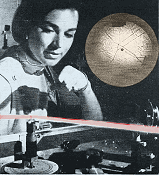 Lithium niobate is used today as the substrate
for surface acoustic wave (SAW) filters, oscillators, optical waveguides, and many
other applications. It, along with barium niobate, was used experimentally by Radio
Corporation of America (RCA) for storing optical images that can be read out later
using a laser. This 1972 issue of Popular Electronics magazine included
a brief news item referencing the work being done. I could not locate any information
that indicates any significant commercialization of the process. Patent US3799642
was awarded in 1974 to RCA Corporation for "Holographic Recording on Photochromic
Lithium Niobate." We've come a long way since then with
optical data storage, with CDs, DVDs, Blu-rays, and much greater density into
the petabit realm... Lithium niobate is used today as the substrate
for surface acoustic wave (SAW) filters, oscillators, optical waveguides, and many
other applications. It, along with barium niobate, was used experimentally by Radio
Corporation of America (RCA) for storing optical images that can be read out later
using a laser. This 1972 issue of Popular Electronics magazine included
a brief news item referencing the work being done. I could not locate any information
that indicates any significant commercialization of the process. Patent US3799642
was awarded in 1974 to RCA Corporation for "Holographic Recording on Photochromic
Lithium Niobate." We've come a long way since then with
optical data storage, with CDs, DVDs, Blu-rays, and much greater density into
the petabit realm...
 One aspect of advertising on the RF Cafe
website I have not covered is using
Google AdSense.
The reason is that I never took the time to explore how - or even whether it is
possible - to target a specific website for displaying your banner ads. A couple
display opportunities have always been provided for Google Ads to display, but the
vast majority of advertising on RF Cafe is done via private advertisers. That is,
companies deal with me directly and I handle inserting their banner ads into the
html page code that randomly selects and displays them. My advertising scheme is
what the industry refers to as a "Tenancy Campaign," whereby a flat price per month
is paid regardless of number of impressions or clicks. It is the simplest format
and has seemed to work well for many companies. With nearly 4 million pageviews
per year for RFCafe.com, the average impression rate per banner ad is about 280k
per year (in eight locations on each page, with >17k pages)... One aspect of advertising on the RF Cafe
website I have not covered is using
Google AdSense.
The reason is that I never took the time to explore how - or even whether it is
possible - to target a specific website for displaying your banner ads. A couple
display opportunities have always been provided for Google Ads to display, but the
vast majority of advertising on RF Cafe is done via private advertisers. That is,
companies deal with me directly and I handle inserting their banner ads into the
html page code that randomly selects and displays them. My advertising scheme is
what the industry refers to as a "Tenancy Campaign," whereby a flat price per month
is paid regardless of number of impressions or clicks. It is the simplest format
and has seemed to work well for many companies. With nearly 4 million pageviews
per year for RFCafe.com, the average impression rate per banner ad is about 280k
per year (in eight locations on each page, with >17k pages)...
These archive pages are provided in order to make it easier for you to find items
that you remember seeing on the RF Cafe homepage. Of course probably the easiest
way to find anything on the website is to use the "Search
RF Cafe" box at the top of every page.
About RF Cafe.
Homepage Archive Pages
2024:
Jan |
Feb |
Mar |
Apr |
May |
Jun |
Jul |
Aug |
Sep |
Oct |
Nov |
Dec
2023:
Jan |
Feb |
Mar |
Apr |
May |
Jun |
Jul |
Aug |
Sep |
Oct |
Nov |
Dec
2022:
Jan |
Feb |
Mar |
Apr |
May |
Jun |
Jul |
Aug |
Sep |
Oct |
Nov |
Dec
2021:
Jan |
Feb |
Mar |
Apr |
May |
Jun |
Jul |
Aug |
Sep |
Oct |
Nov |
Dec
2020:
Jan |
Feb |
Mar |
Apr |
May |
Jun |
Jul |
Aug |
Sep |
Oct |
Nov |
Dec
2019:
Jan |
Feb |
Mar |
Apr |
May |
Jun |
Jul |
Aug |
Sep |
Oct |
Nov |
Dec
2018:
Jan |
Feb |
Mar |
Apr |
May |
Jun |
Jul |
Aug |
Sep |
Oct |
Nov |
Dec
2017:
Jan | Feb |
Mar |
Apr |
May |
Jun |
Jul |
Aug |
Sep |
Oct |
Nov |
Dec
2016:
Jan |
Feb |
Mar |
Apr |
May |
Jun |
Jul |
Aug |
Sep |
Oct |
Nov |
Dec
2015:
Jan |
Feb |
Mar |
Apr |
May |
Jun |
Jul |
Aug |
Sep |
Oct |
Nov |
Dec
2014:
Jan |
Feb |
Mar |
Apr |
May |
Jun |
Jul |
Aug |
Sep |
Oct |
Nov |
Dec
2013:
Jan |
Feb |
Mar |
Apr |
May |
Jun |
Jul |
Aug |
Sep |
Oct |
Nov |
Dec
2012:
1 |
2 |
3 |
4 |
5 |
6 |
7 |
8 |
9 |
10 |
11 |
12 |
13 (no archives before 2012)
|

 Nickel cadmium (NiCd or NiCad)
Nickel cadmium (NiCd or NiCad)


 Phase, feedback, and instability
Phase, feedback, and instability






 Wireless power distribution
Wireless power distribution





 Westinghouse
Westinghouse


 When RF Cafe visitor Ed W. saw the photo
I posted of the très cool looking miniature isolation transformers from the "
When RF Cafe visitor Ed W. saw the photo
I posted of the très cool looking miniature isolation transformers from the "






